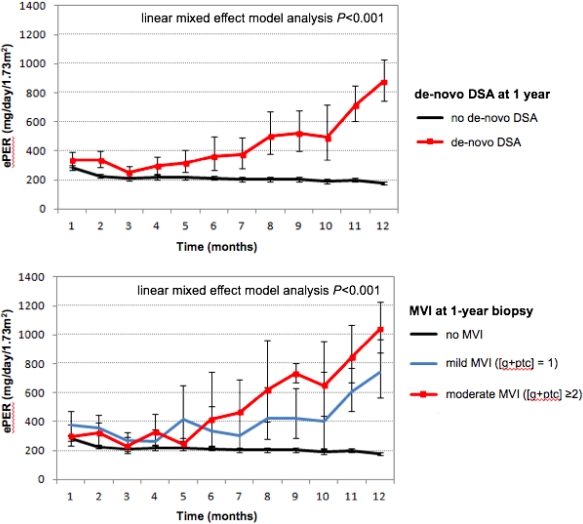An Increase in Spot Urine Protein Excretion during the First Year after Kidney Transplantation Associates with Subclinical De-Novo Donor-Specific Antibodies and Microvascular Inflammation at 1-Year Surveillance Biopsies
1Department of Nephrology, University Medical Centre Ljubljana, Ljubljana, Slovenia
2Institute of Pathology, University of Ljubljana, Ljubljana, Slovenia.
Meeting: 2018 American Transplant Congress
Abstract number: A112
Keywords: Antibodies, Endothelial activation, Kidney transplantation, Proteinuria
Session Information
Session Name: Poster Session A: Kidney Acute Antibody Mediated Rejection
Session Type: Poster Session
Date: Saturday, June 2, 2018
Session Time: 5:30pm-7:30pm
 Presentation Time: 5:30pm-7:30pm
Presentation Time: 5:30pm-7:30pm
Location: Hall 4EF
Introduction. We investigated whether an increase in spot urine protein excretion during the first year after kidney transplantation associates with subclinical de-novo donor-specific antibodies (DSA) and microvascular inflammation (MVI) at 1 year.
Methods. This prospective study included 79 non-sensitized patients who received a kidney transplant between Dec 2013 and Jan 2016. Estimated protein excretion rate (ePER) was calculated monthly from spot urine protein/creatinine ratios. At 1 year, all recipients underwent surveillance graft biopsy. The presence of subclinical de-novo DSA was determined on the basis of single antigen bead reactivity using a MFI threshold >1000 and stable graft function (serum creatinine variability <25%). Biopsies were read by a single pathologist and presence of MVI (glomerulitis [g] and/or peritubular capillaritis [ptc] score >0) was graded in accordance with Banff 2013 criteria.
Results. At 1 year after transplant, 10 patients (13%) developed de-novo DSA, and 12 patients (15%) had histologic evidence of MVI: 7 patients had mild MVI with [g+ptc] =1, and 5 patients had moderate MVI with [g+ptc] ≥2. Patients with de-novo DSA had greater mean ePER at 1 year than those without DSA (870, 95% CI 770–1040 vs. 192, 95% CI 178–206 mg/day/1.73m2; P<0.001). Compared with absence of MVI, mild and moderate MVI were associated with an increase in mean ePER at 1 year (no MVI: 190, 95% CI 178–202 vs. mild MVI: 740, 95% CI 578–926 vs. moderate MVI: 1022, 95% CI 884–1226 mg/day/1.73m2; P<0.001). Linear mixed effect regression analyses demonstrated a significant difference in slope of ePER during the first year between patients with no DSA and de-novo DSA (P<0.001), and between patients different MVI scores at 1 year (P<0.001).
Conclusions. An increase in ePER during the first year after kidney transplantation associates with subclinical de-novo DSA and the degree of MVI at 1-year surveillance biopsies.
CITATION INFORMATION: Arnol M., Mlin[scaron]ek G., Oblak M., Kandus A., Kojc N., Buturović-Ponikvar J. An Increase in Spot Urine Protein Excretion during the First Year after Kidney Transplantation Associates with Subclinical De-Novo Donor-Specific Antibodies and Microvascular Inflammation at 1-Year Surveillance Biopsies Am J Transplant. 2017;17 (suppl 3).
To cite this abstract in AMA style:
Arnol M, Mlin[scaron]ek G, Oblak M, Kandus A, Kojc N, Buturović-Ponikvar J. An Increase in Spot Urine Protein Excretion during the First Year after Kidney Transplantation Associates with Subclinical De-Novo Donor-Specific Antibodies and Microvascular Inflammation at 1-Year Surveillance Biopsies [abstract]. https://atcmeetingabstracts.com/abstract/an-increase-in-spot-urine-protein-excretion-during-the-first-year-after-kidney-transplantation-associates-with-subclinical-de-novo-donor-specific-antibodies-and-microvascular-inflammation-at-1-year-su/. Accessed January 7, 2026.« Back to 2018 American Transplant Congress

